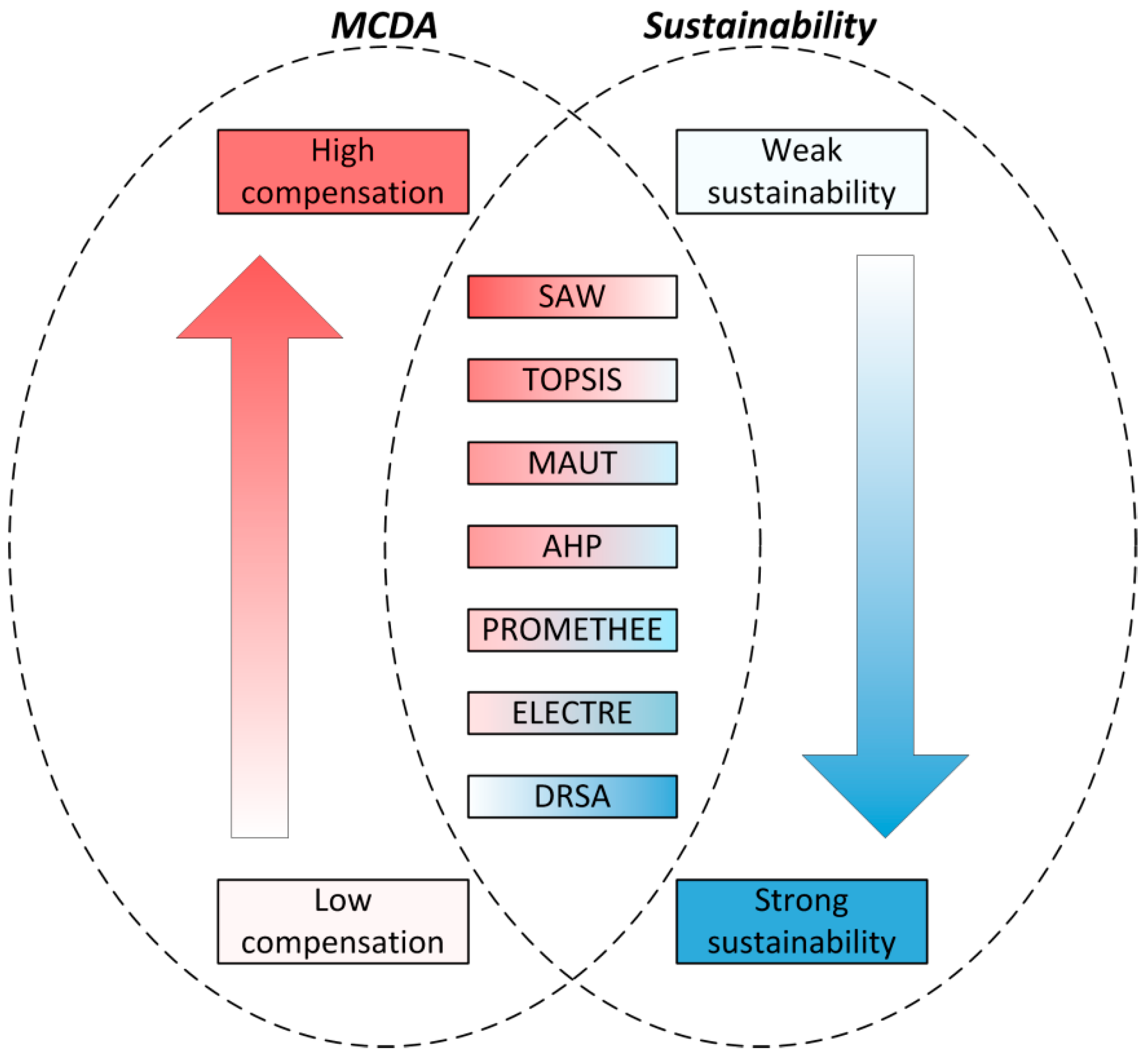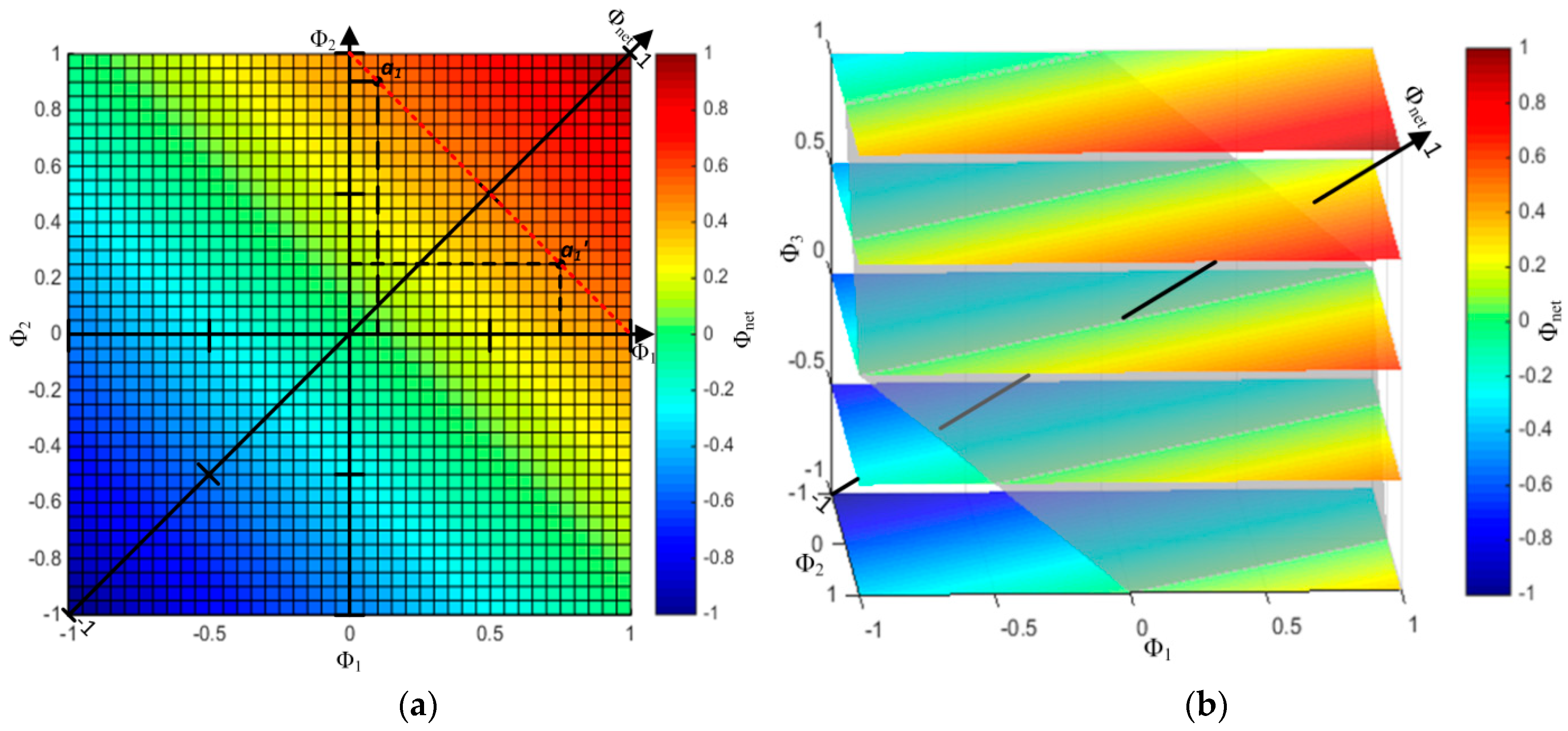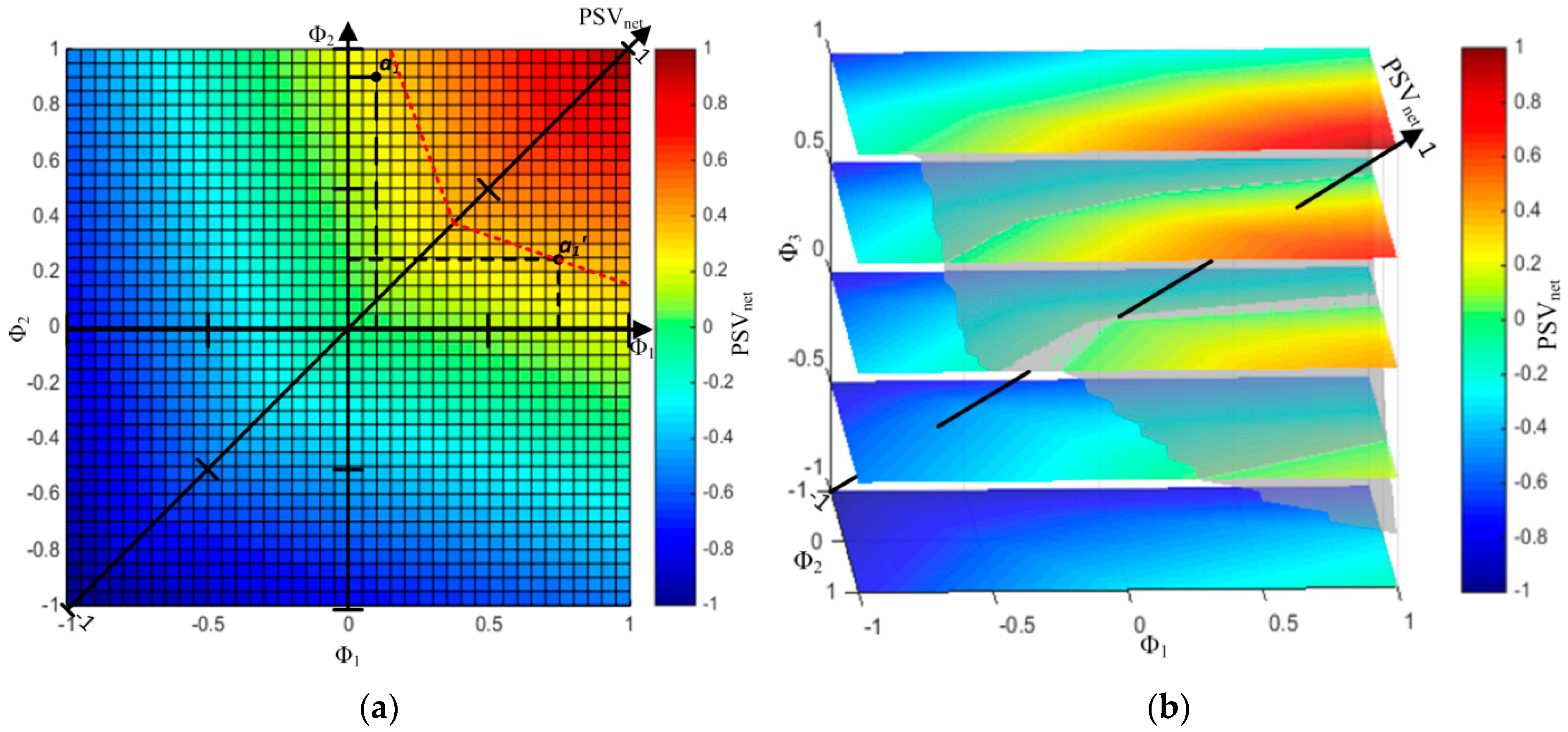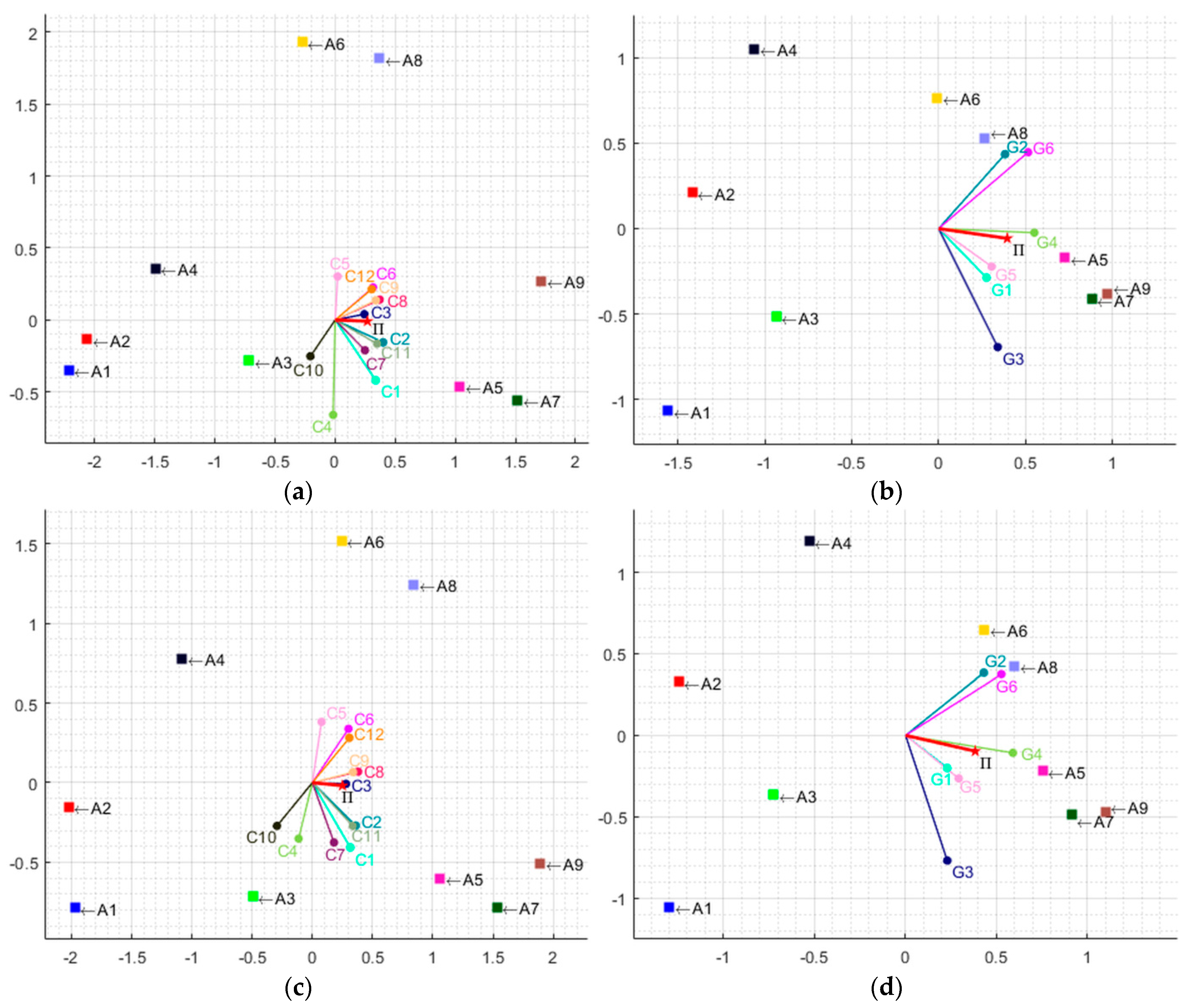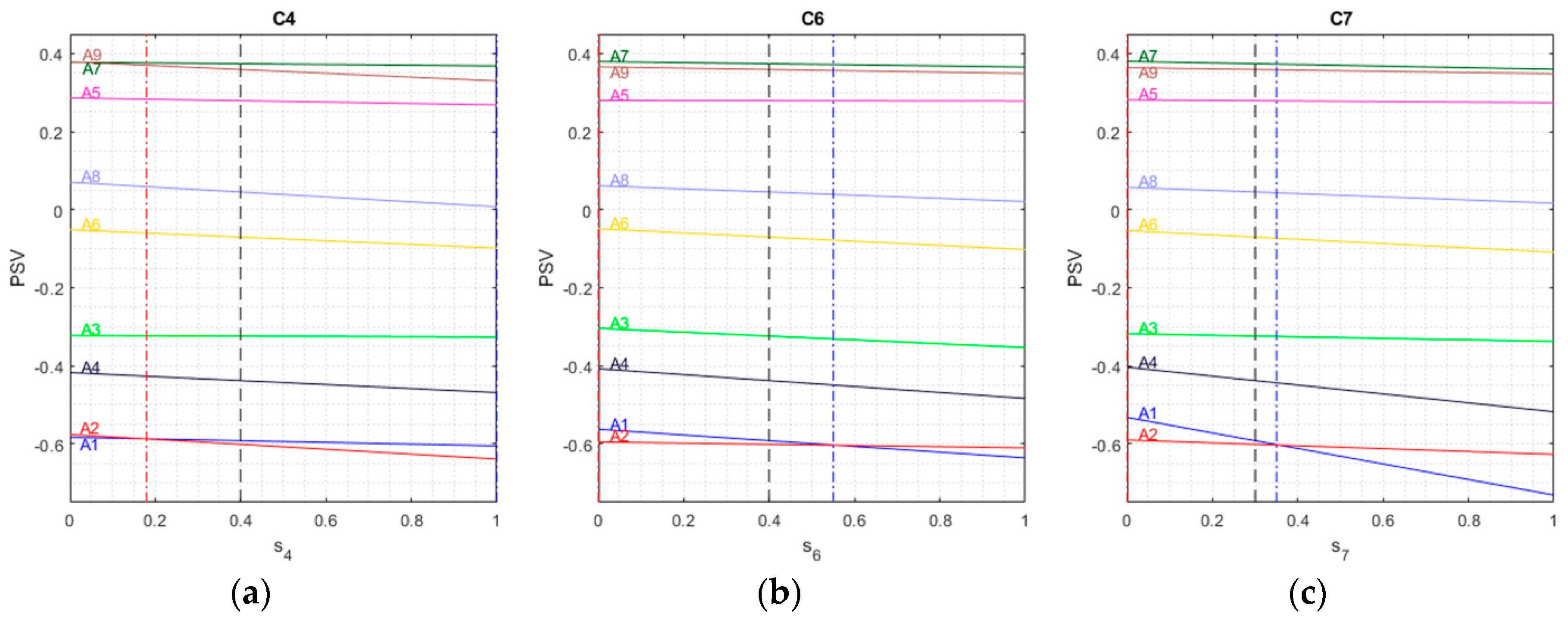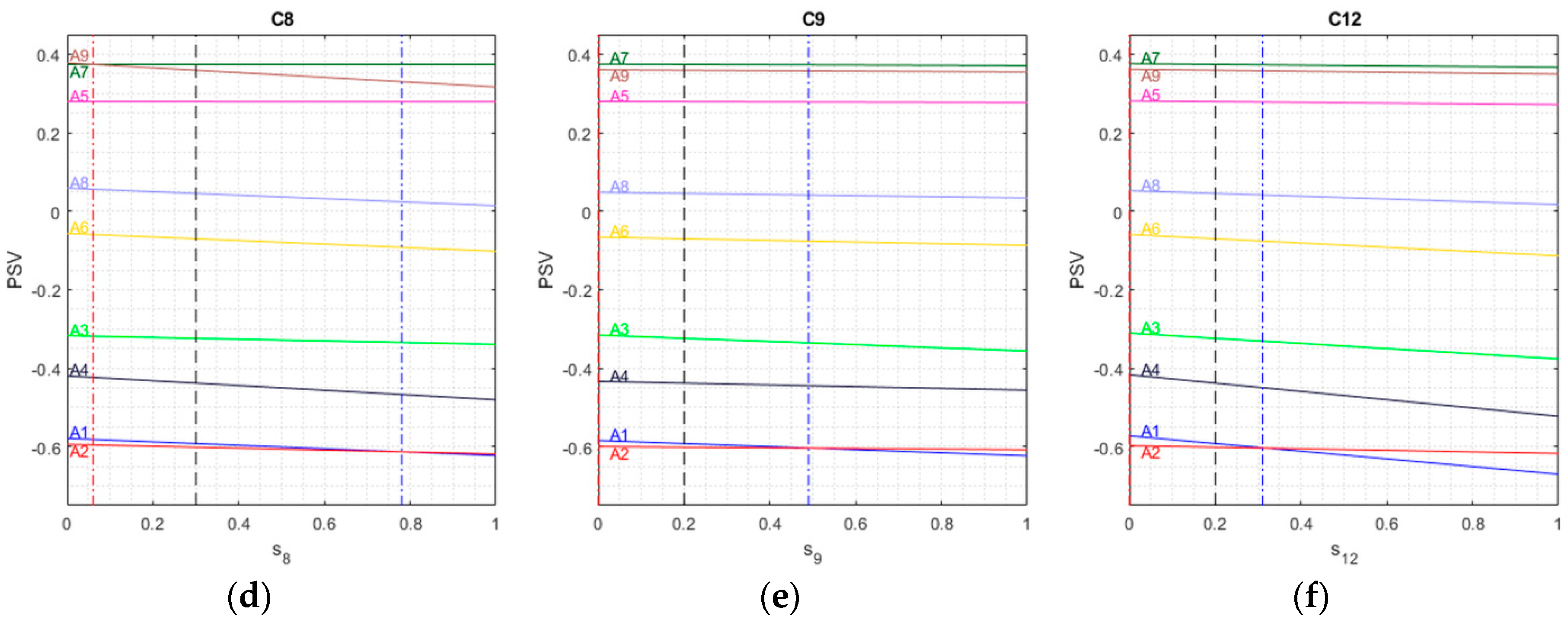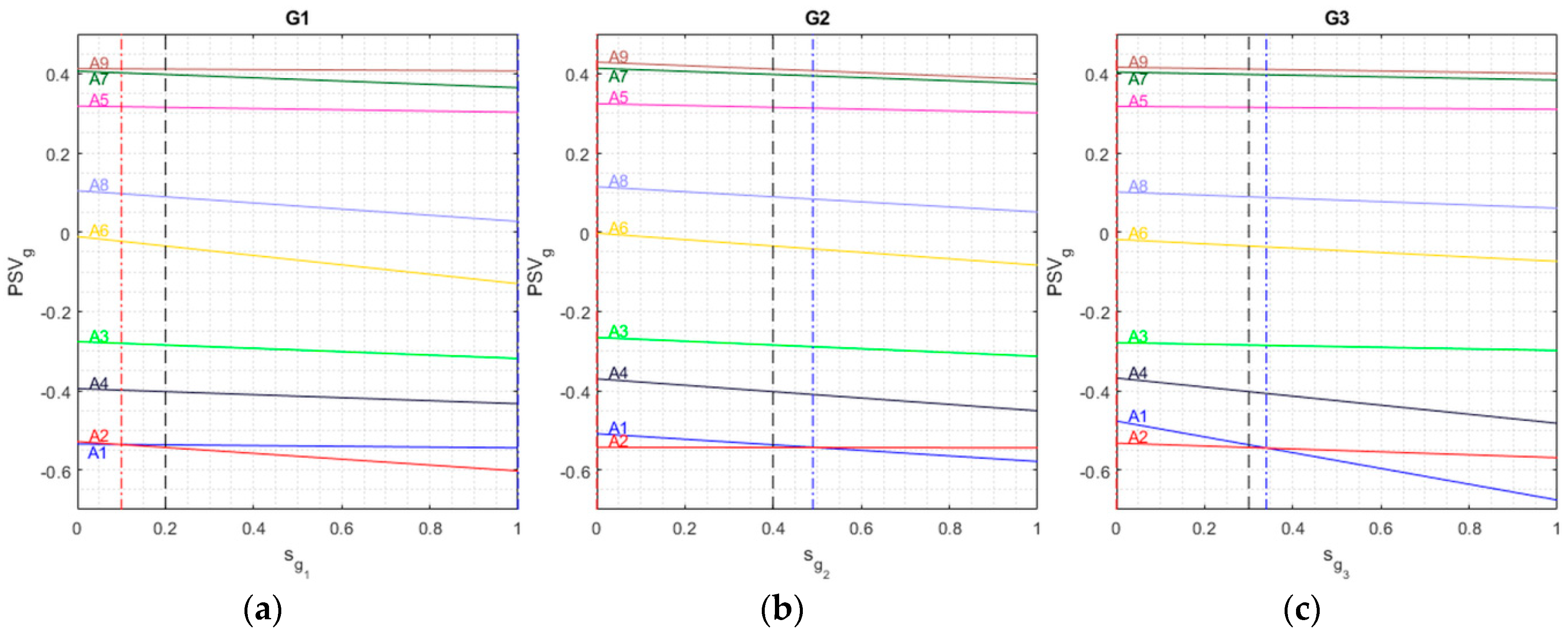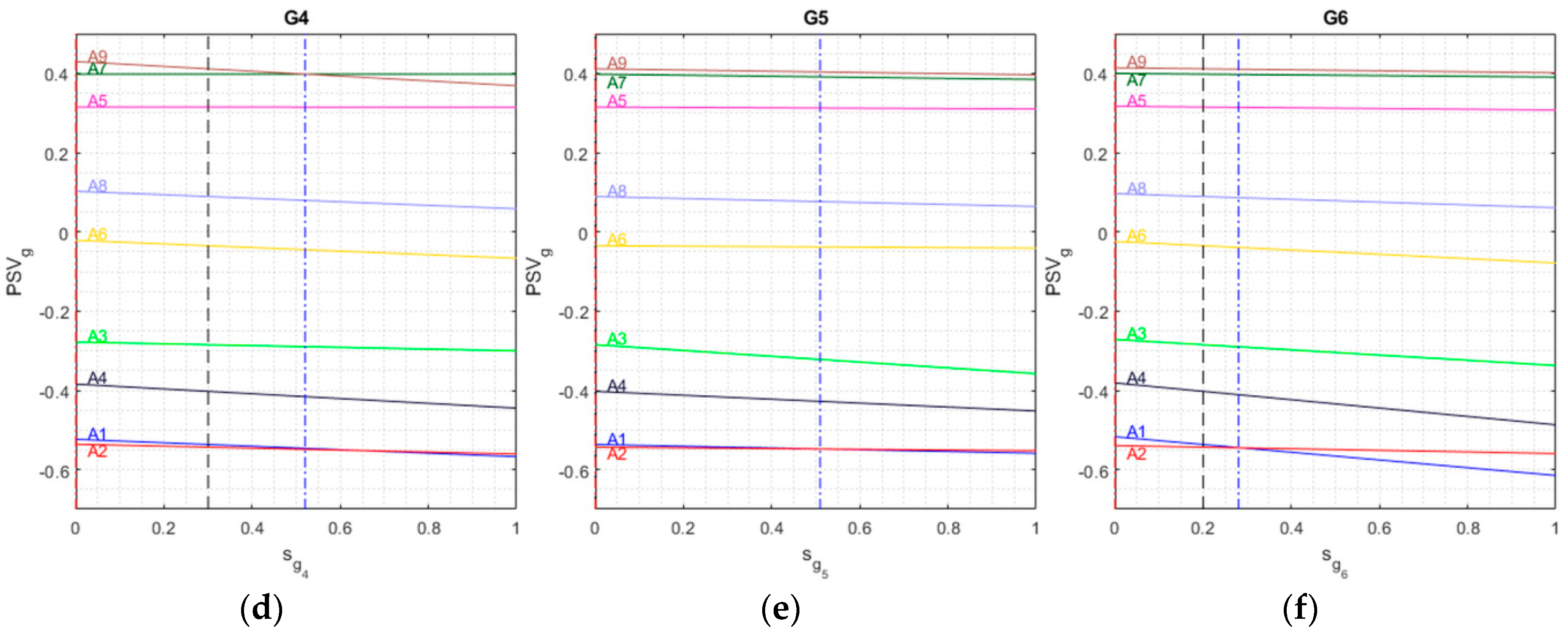One of the basic characteristics of MCDA methods is the compensation degree of the criteria. This characteristic is related to the strength of sustainability of the decision problem solution. Therefore, the choice of a specific MCDA method has a direct impact on the achievable strength of sustainability.
2.1. Compensation and Sustainability Strength of the MCDA Methods
In the phenomenon of compensation, the ‘disadvantage’ of a decision alternative with regard to one of the criteria can be offset by a sufficiently large ‘advantage’ on another criterion [
26]. The literature distinguishes three types of the MCDA methods: (1) compensatory, (2) partially-compensatory and (3) non-compensatory [
14,
27]. It is generally acknowledged that the MCDA methods using a single synthesizing criterion or a utility theory are more compensatory than those based on outranking [
19,
28]. Moreover, the methods employing an additive aggregation model are more compensatory than those applying multiplicative aggregation [
29,
30]. Munda [
31] points out that compensation is related to the way of interpreting weights of criteria. Using weights in terms of an intensity of preference/trade-offs between criteria makes the method compensatory. On the other hand, the use of weights as importance coefficients/ordinal scores makes the MCDA method non-compensatory [
31]. Nonetheless, with some MCDA methods, such as AHP (Analytic Hierarchy Process) and PROMETHEE, it is difficult to determine if the weights are used as trade-offs or importance coefficients. It makes it difficult to determine the compensation degree of these methods [
16]. Similarly, in the case of other MCDA methods, it is challenging to determine their compensation degree. For instance, ELECTRE (ELimination Et Choice Translating REality) methods are considered by many researchers as non-compensatory [
32,
33]. However, others believe they are marked by partial compensation [
27,
28]. Thus, qualifying an MCDA method as compensatory, non-compensatory or partially-compensatory is not easy.
In the literature, a strong relationship between the compensation degree and weak and strong sustainability paradigms is stressed. Compensation validates substitution; therefore, compensatory methods are employed in problems related to weak sustainability, whereas non-compensatory methods are suitable for solving decision problems referring to strong sustainability [
16,
19]. In other words, a low compensation degree is reflected by the strong sustainability paradigm, whereas a high compensation degree corresponds to the weak sustainability paradigm.
Nevertheless, it should be noted that in many MCDA methods, the compensation degree, as well as the sustainability strength, depends on decision problem parameters provided by the decision maker. For instance, in the PROMETHEE and ELECTRE methods, the compensation degree can be adjusted to a certain extent by proper manipulation of the threshold values of indifference (
q) and preference (
p) [
16,
20]. Additionally, in the ELECTRE methods, compensation can be limited by proper values of veto thresholds (
v) for criteria [
16,
26]. On the other hand, in the DRSA method [
34], which is considered as non-compensatory [
16,
35], compensation is adjusted by attributes of objects/actions defined by the decision maker in a data table. For example, if in a data table consisting of two conditional attributes (criteria)
c1,
c2 and a decision attribute
d, there will be an object
a which has the values
c1(a) = 0,
c2(a) = 1,
d(a) = 1; this means that strong compensation of a criterion
c1 by a criterion
c2 is permissible. As one can notice, in the aforementioned MCDA methods, the adjustment of a compensation degree is carried out indirectly; therefore, decision makers may find it difficult to select a proper degree of criteria compensation depending on needs, and to modify the compensation degree in order to analyse the solution to a decision problem.
Taking into consideration the difficulties with determining the compensation degree of some MCDA methods, and taking into account the fact that in many MCDA methods, the compensation degree can be adjusted, it is rational to talk about higher- or lower-degree compensation methods rather than categorizing methods such as compensatory, partially-compensatory or non-compensatory.
Figure 1 presents an order of selected MCDA methods depending on their average compensation degree and a corresponding sustainability strength obtained for the decision problem solution [
16,
20,
27,
35,
36,
37].
2.2. PROMETHEE II and PROSA Methods
In the PROMETHEE II method, as in other MCDA methods, one can distinguish three main stages: preference modelling, aggregation and exploitation [
38] (p. 163), which are elements of a five-stage decision-aid process [
39]. As Bouyssou [
38] (p. 165) points out, individual stages can be merged, which simplifies the PROMETHEE II computational procedure to a particular case of an additive value function model. What is more, it should be noted that the three-stage PROMETHEE II computational procedure can be conducted in two ways producing the same results [
40] (p. 162): a classical one based on the aggregation of fuzzy preference relations into global preferences (aggregated preference indices) [
38] (p. 163), employing net flows of a single criterion [
40] (p. 197) [
24] (p. 200).
The classical approach makes it possible to obtain a partial order and total order of alternatives, and can be employed in the PROMETHEE I and II methods. The approach based on single criterion net flows can be used in the PROMETHEE II method, and it can serve as the basis for GAIA analyses. Also, it can be used in the generalized PROSA method. Therefore, this approach will be presented below.
Preference modelling consists in selecting a preference function
for every criterion from among
n criteria. Next, for every criterion, a fuzzy preference relation
according to the formula (1) is calculated:
where
A is a fine set of
m decision alternatives,
denotes evaluation/performance of an alternative
a with regard to a criterion
.
At the aggregation stage, for every alternative a single criterion net flow with the use of the formula (2) is determined:
The last exploitation stage consists in calculating a net outranking flow according to the formula (3):
where
is the weight of a criterion
j, and the sum of weights is 1. The normalization of weights to 1 is carried out before the exploitation stage according to the formula (4):
The ranking of alternatives is constructed on the basis of the obtained net outranking flow values.
The analysis of formulas (1)–(3) allows us to notice that in the PROMETHEE II method, one can adjust the compensation degree only at the stage of preference modelling and the weights used in the method are employed as trade-offs because of the application of an additive aggregation model. This is confirmed by
Figure 2, presenting a space of solutions
, depending on single criterion net flows obtained for two (
Figure 2a) and three (
Figure 2b) criteria with equal weights.
Figure 2a depicts a hypothetical alternative
, whose net flow value equals
and
. Therefore, the value
. The same value
will be assigned to an alternative
where
and
. As shown, the alternative
is more sustainable than
(low performance of a criterion
is to a lesser extent compensated by high performance of a criterion
); however, according to the PROMETHEE II computational procedure, both alternatives, regardless of the sustainability of each of them, are characterized by the same performance. Generally speaking, it can be noted that for bicriteria problems, the value
is determined by a straight line orthogonal to a vector
, whereas for tricriteria problems, the value
is determined by a plane orthogonal to the vector
. For decision problems with a higher number of criteria, the value
is determined by analogous hyperplanes. In
Figure 2b, a plane was marked which determines the location of possible alternatives for which the value
is 0, in the space of three criteria (three single criterion net flows). On the basis of
Figure 2, it can be concluded that a decision alternative is sustainable if it is located in an
n-dimensional space
near the vector
, therefore it takes similar values
for every criterion.
Figure 2a,b clearly depict that the value
increases linearly depending on the value of single criterion net flows and the PROMETHEE II method, when determining a ranking, does not take into consideration sustainability of alternatives. Therefore, the compensation degree of criteria, with the exception of the preference modelling stage, is high. The PROSA method is to decrease the compensation degree of criteria at the exploitation stage in such a way so that more sustainable alternatives were preferred. In addition, in the generalized PROSA method, the ability to flexibly adjust the compensation degree and to carry out the sensitivity analysis from the perspective of the compensation degree (sustainability strength) is essential.
The first version of the PROSA method [
25] is an extension of the PROMETHEE II, based on four net outranking flow values. These values are calculated individually for the global result (
), as well as economic (
), social (
) and environmental (
) criteria. The PROSA method uses a weighted mean absolute deviation that addresses the aforementioned groups of criteria in accordance with the formula (5):
As a result of the weighted MAD measure, the global assessment of alternatives in the PROSA method is based on the formula (6):
2.3. Justification and Research Gap
The wide usability of MCDA methods in decision problems related to sustainability is due to the fact that SD and SA problems are complex and require that many, often contradictory, criteria and uncertainties need to be considered [
13,
28]. The MCDA methods are designed to solve decision problems which have the characteristics (high complexity of a problem, conflicts between criteria, uncertainty), which allows their users to make decisions in a structured, transparent and reliable manner [
12,
16]. Moreover, the characteristics of the MCDA methods are consistent with weak and strong sustainability paradigms because of a different compensation degree of the criteria which are used in the individual methods.
An analysis of the literature indicates that in decision problems related to sustainability the following methods are most often used: WAM/SAW (Weighted Arithmetic Mean/Simple Additive Weighting), AHP, TOPSIS (Technique for Order of Preference by Similarity to Ideal Solution) and MAUT/MAVT (Multi-Attribute Utility Theory/Multi-Attribute Value Theory) [
9,
12,
17,
41]. Moreover, the majority of formal sustainability indices use a weighted average or a sum of sustainability indicators [
19,
21]. The following methods, characterized by a lower compensation degree, are considerably less frequently used in such decision problems: ELECTRE, PROMETHEE and DRSA (Dominance-based Rough Sets Approach) [
4,
12]. Therefore, decision problems in the field of sustainability are most often solved from the perspective of weak sustainability. However, as it has been noted, in decision problems of this type, the strong sustainability perspective is usually recommended [
18,
19,
20]. Furthermore, strong sustainability is preferred in most decision contexts [
35]. What is more, there is no MCDA method which would allow the decision maker to easily carry out a sensitivity analysis taking into account changes in the compensation degree and thereby changes in the sustainability strength.
From among the MCDA methods used in the context of sustainability, the PROMETHEE II method is worthy of particular attention. This method (including fuzzy versions) is widely used in decision-making problems related to sustainable development [
42,
43] and digital sustainability [
44], and some of its unique features are useful for sustainability assessment. Thanks its use of six different preference functions, PROMETHEE II makes it possible to solve a decision problem taking into account both weaker sustainability and stronger one (higher and lower compensation degrees). This results from the fact that by fulfilling certain conditions by a preference model, and by applying the first (usual criterion) or the third (V-shape) preference function, the PROMETHEE II method works as the Borda’s method or SAW [
45,
46], ([
38] p. 196) respectively. Both methods are characterized by a high compensation degree and also weaker sustainability [
30]. On the other hand, if, for instance, the fifth preference function (V-shape with indifference area) with appropriate threshold values
q and
p is used, then a lower compensation degree and consequently stronger sustainability is obtained. It should be noted that the use of the thresholds
q and
p in PROMETHEE II makes it possible to take into account the decision maker’s uncertainty in a decision problem [
47]. Furthermore, PROMETHEE enables its users to conduct a sensitivity analysis with regard to changes of weights of criteria and changes of input data which, as a result, makes it possible to analyse the reliability and robustness of a solution. Such analyses are highly recommended when solving decision problems concerning sustainability [
12,
17,
29,
48]. Moreover, PROMETHEE renders the GAIA tool accessible, which allows potential users to analyse a decision problem from a descriptive perspective. The PROMETHEE II method normalizes criteria to the scale [0, 1] and offers full comparability of alternatives with the use of the global scale [−1, 1]. Taking the process of normalization of partial evaluation into account is crucial in the PROMETHEE II method, since it is one of significant SA stages [
12,
17,
48]. On the other hand, the ability of full comparability of alternatives is in conformity with the tendency, which has recently been visible, of using the MCDA methods, which construct a complete ranking of alternatives, in SA [
12].
In [
25], we presented the PROSA method based on PROMETHEE II. PROSA is characterized by a lower compensation degree than PROMETHEE II, and therefore, has stronger sustainability. This method makes it possible to use the six different preference functions used in PROMETHEE; therefore, PROSA makes it possible to modify a compensation degree and take preference uncertainty into consideration. PROSA, like PROMETHEE II, applies criteria normalization to the scale [0, 1] and allows the user to obtain a complete ranking of alternatives. Analogously to PROMETHEE, it enables its users to carry out a sensitivity analysis of a solution to changes of weights of criteria and changes of evaluations of alternatives. It should be noted that PROSA extends the PROMETHEE II computational procedure and, unlike PROMETHEE, is characterized by nonlinear sensitivity to changes of weights of criteria [
25]. Moreover, PROSA, as is the case with ELECTRE III with a veto threshold, triggers ranging of alternatives with ‘well-balanced’ evaluations before ‘poorly-balanced’ alternatives [
26].
Nevertheless, PROSA has also certain disadvantages. First of all, a ranking of variants is constructed only on the basis of three sustainability pillars, i.e., economic, social and environmental, without considering other sustainability dimensions. Furthermore, in the further stages of the computational procedure, it operates on sustainability dimensions without the ability to take detailed criteria into account. However, as Munda points out [
30,
31], in sustainability problems, using individual criteria and considering groups of criteria (dimensions) may yield different results. Also, the GAIA procedure, which would describe a decision problem from the perspective of a solution obtained via the PROSA method, has not been presented (a GAIA plane presented in [
25] refers to a solution obtained with the use of the PROMETHEE method, not PROSA). Finally, PROSA, as well as PROMETHEE II and other MCDA methods, allow the user to manipulate the compensation degree only indirectly, in particular by the selection of proper preference function and by modifying the values of the thresholds
q and
p in the preference model. As a result, conducting a sensitivity analysis of a solution on the change of a compensation degree/sustainability strength is difficult.
Due to the aforementioned disadvantages, it is justified to undertake efforts to create a new generalized PROSA method which would derive the positive characteristics of the PROMETHEE II and PROSA methods, while at the same time avoiding their shortcomings in the context of sustainability assessment.
The generalized PROSA ought to make it possible to consider sustainability of any dimensions and to provide the decision maker with the possibility of deciding whether SA is to be determined on the level of individual criteria or sustainability dimensions (groups of criteria).
In addition, one needs to complete the PROSA method with the GAIA analysis which will graphically describe a solution obtained with the use of PROSA.
A presented generalization should also provide decision makers with the ability to elastically adjust the compensation degree of individual criteria or sustainability dimensions related to sustainability of a solution.
The adjustment of the compensation degree by decision makers ought to be conducted directly with the use of an unambiguous number coefficient in the range from the weakest to strongest sustainability.
Moreover, the decision maker should have the ability to carry out a sensitivity analysis because of the change of the compensation degree/sustainability strength.
All requirements related to the compensation degree are inspired by Giarlotta’s postulate [
49], i.e., that the compensation degree is not a characteristic of the MCDA method, but an internal/intrinsic characteristic feature of the decision maker. As a result, the generalized PROSA method should give the decision maker a broad spectrum of possibilities in terms of defining and analysing a sustainability decision problem, providing him or her with indispensable information which is necessary to verify an obtained solution both from a prescriptive perspective and a descriptive one. As indicated above, because of certain specific characteristics and their conformity with requirements of problems concerning sustainability, the PROMETHEE II method is interesting.
